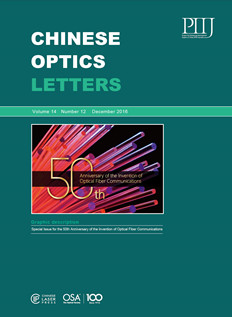
Editor(s): Weisheng Hu, Xiang Liu, Lian K. Chen
Year: 2016
Status: Published
This year marks the 50th anniversary of the invention of the optical fiber communications. To celebrate this special occasion, the Chinese Optics Letters (COL) will publish a Special Issue for the 50th Anniversary of the Invention of Optical Fiber Communications in December 2016. The special issue will include invited papers that present the state-of-the-art results in various areas of optical fiber communications, to illustrate the great accomplishments made in this field through the collective efforts by optical communication researchers worldwide in the past half of a century.
This Review focuses on optical transmission fibers and the high-capacity systems operating thereon. It attempts to combine key lessons learned from the 50-year history of low-loss optical fibers with views on future fiber and systems requirements, discussing likely evolution paths and potential pitfalls in resolving the optical network capacity crunch.
From 2010 to 2015, the Wuhan Institute of Posts and Telecommunications (WRI) had undertaken the national key basic research development program project ‘ultra-high speed, ultra-large capacity, ultra-long distance (3U) optical transmission based research’ as the leading agency. Under the support of the project, we have obtained a series of achievements in scientific research and engineering. Some of the results have been widely used in commercial systems. This Review will make a preliminary summary of the achievements during the past 5 years.
We review the research and development of beyond Pb/s capacity space-division-multiplexed transmission technology using multi-core optical fibers for satisfying the ever-increasing traffic demand. Moreover, we present an optical packet and circuit integrated network technology to improve switching capacity and flexibility in network nodes for the rapid traffic fluctuation and the data service diversification.
The advent of low loss optical fiber has consistently led us to the ultra-broadband era, where bandwidths exceeding 1 Gb/s are commonplace. This Review reviews the early history of fiber access, pointing out some of the lasting design choices and signature features of fiber access. The progress of the various passive optical network technologies is also reviewed, and some views regarding the future trends of fiber in the access.
We present a theoretical analysis, systematic simulation, and experimental measurements for the phase noise, timing jitter, and frequency stability in the frequency distribution of millimeter waves over distant optical fiber links. The conception that the dissemination of a higher frequency reference instead of a lower one can achieve a better frequency stability is discussed and verified. We find that the system’s noise floor, including thermal noise, shot noise, and any other noise from electronic components, is considered to be a fundamental limitation for a frequency reference transmission system. Benefiting from the high-precision time delay variation discrimination and accurate locking control operation, a highly stabilized reference is distributed to a remote end over a 60 km spooled fiber, achieving a frequency stability of 4×10 17 at an average time 1000 s, corresponding to 23 fs of RMS timing jitter (0.01 Hz–1 MHz).
The uses of optical fibers are numerous, and over the past few decades, they have extended from optical fiber communications to a wide variety of sensing applications. In particular, fiber Bragg grating (FBG) sensors inscribed in single-mode optical fibers offer significant advantages over more conventional electrical sensors and have been successfully deployed in many different industries. In this Review, we review the applications of intrinsic FBG pressure and flow sensors in oil and gas and the deployment of FBG sensing networks in railways. The promising prospect of using polymer FBGs in wearable medical devices is also described.















